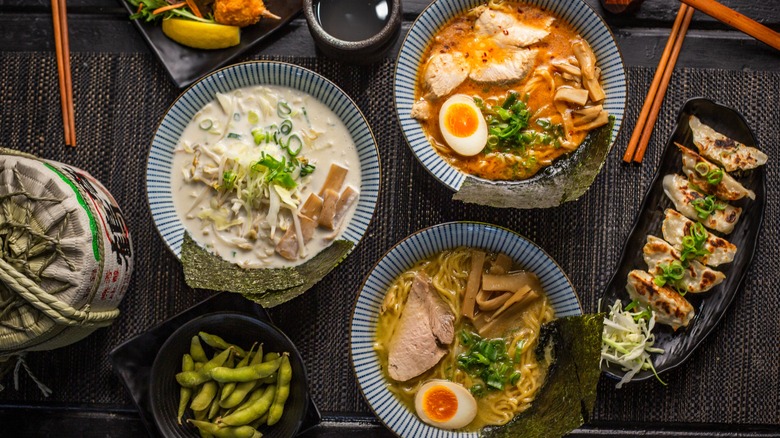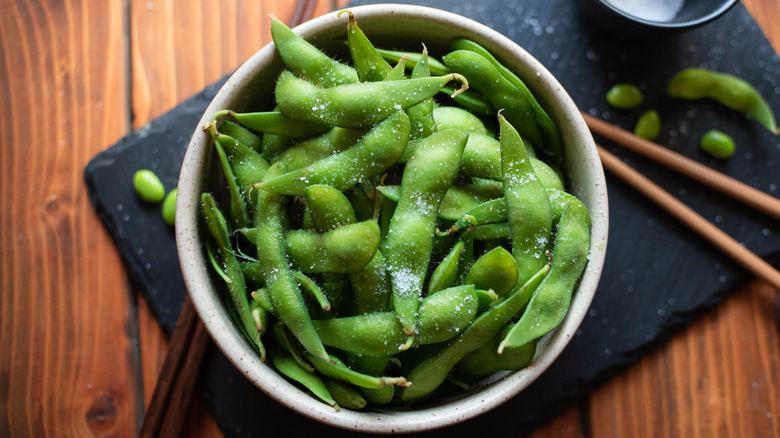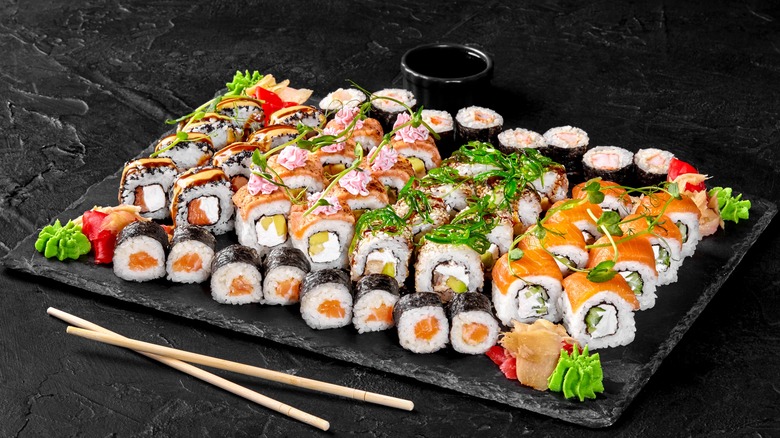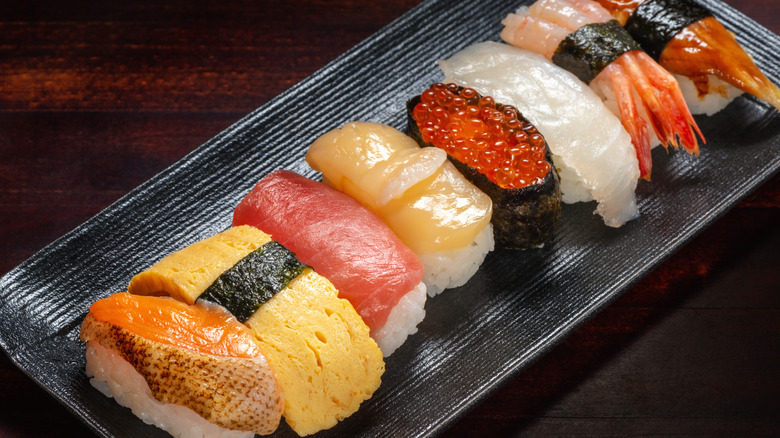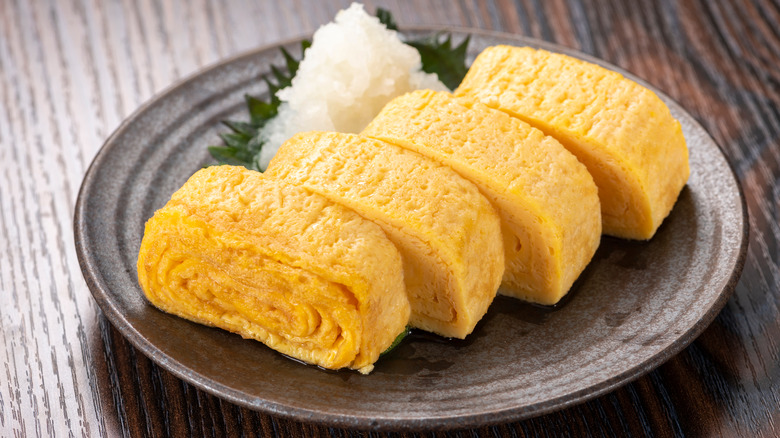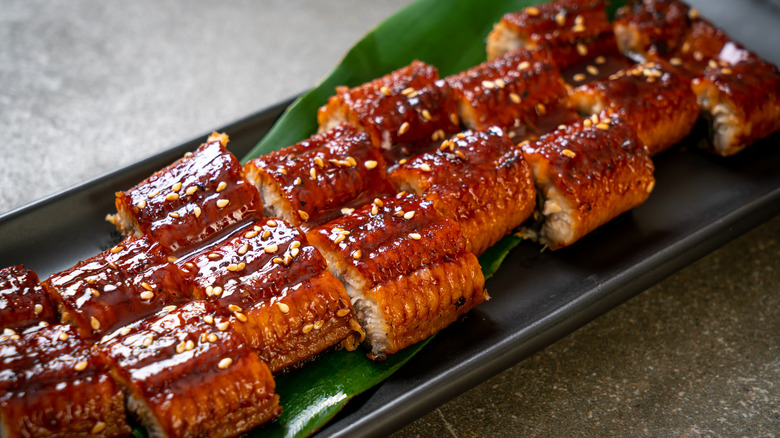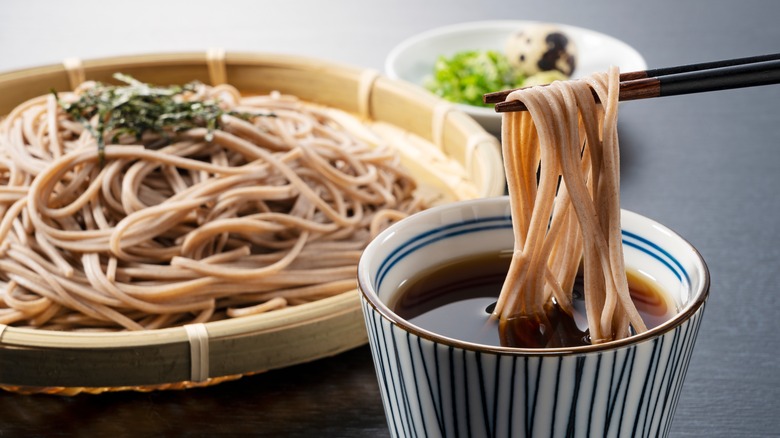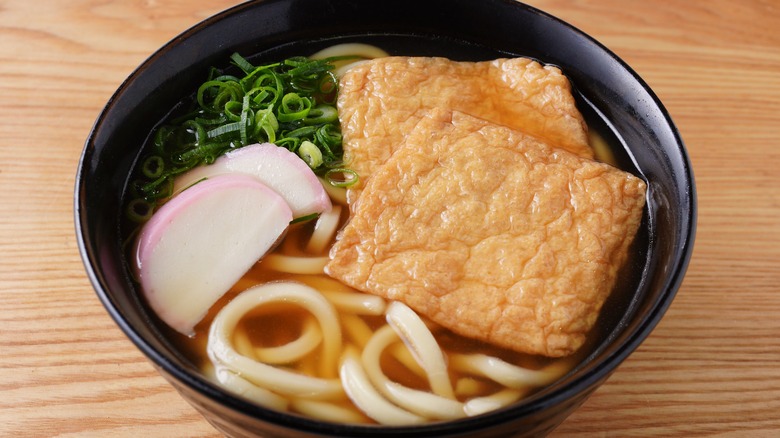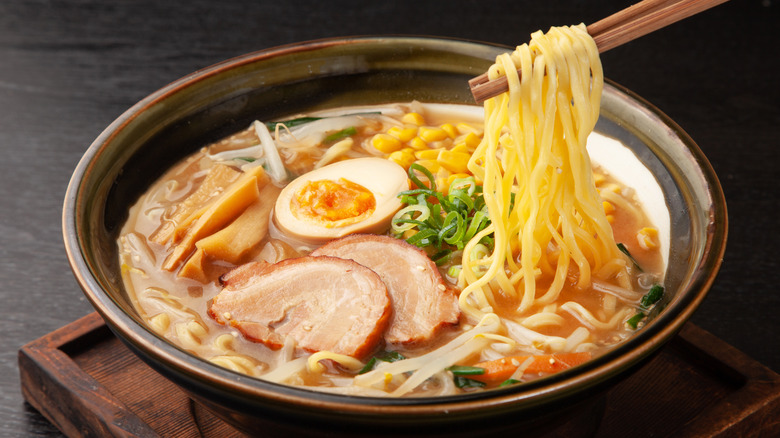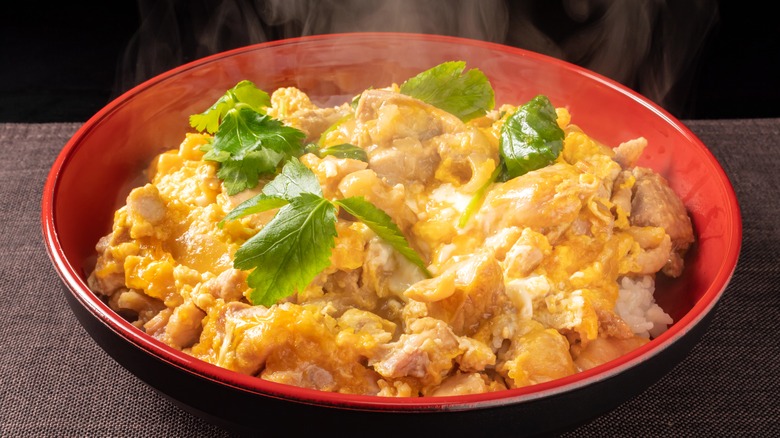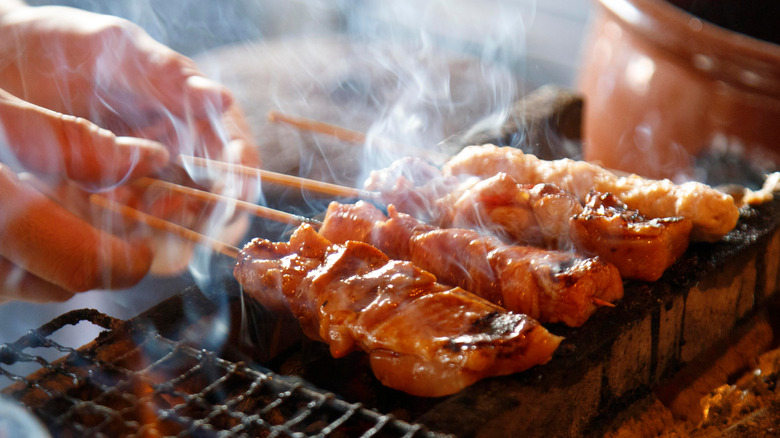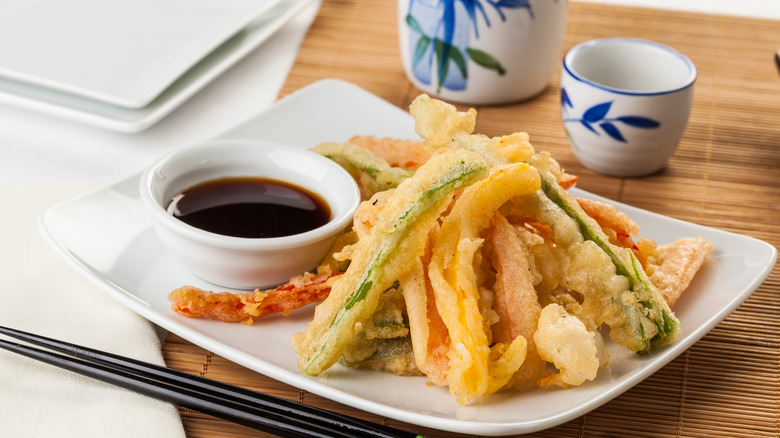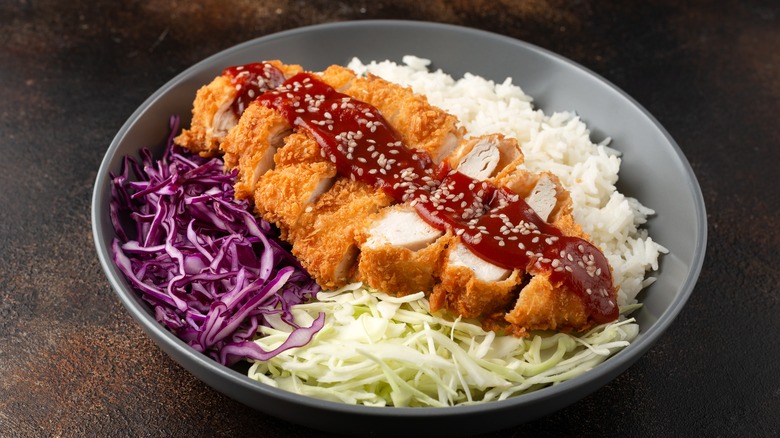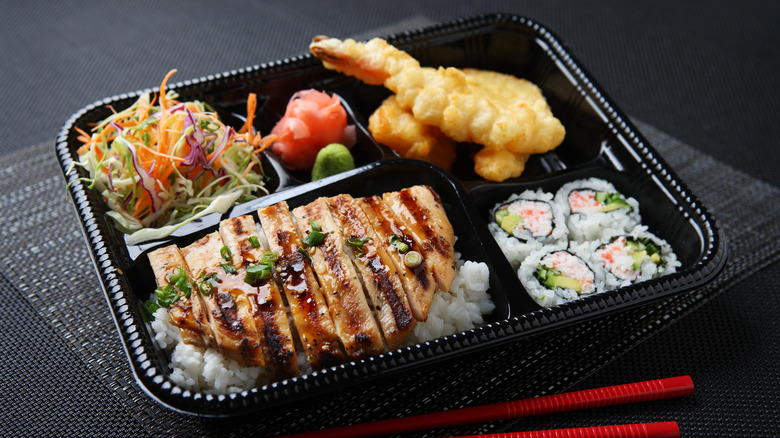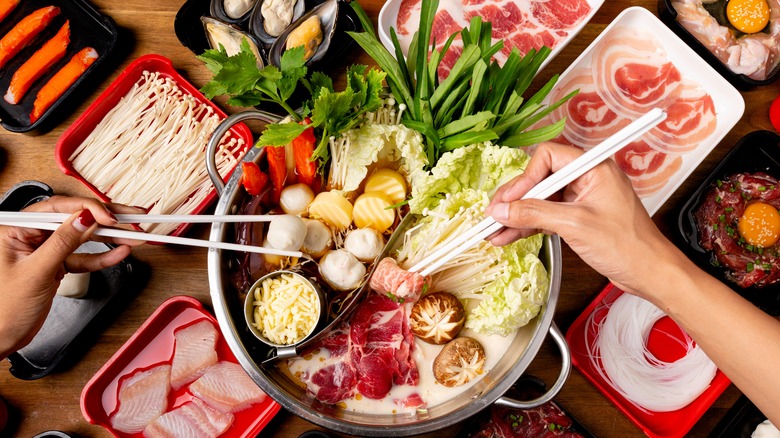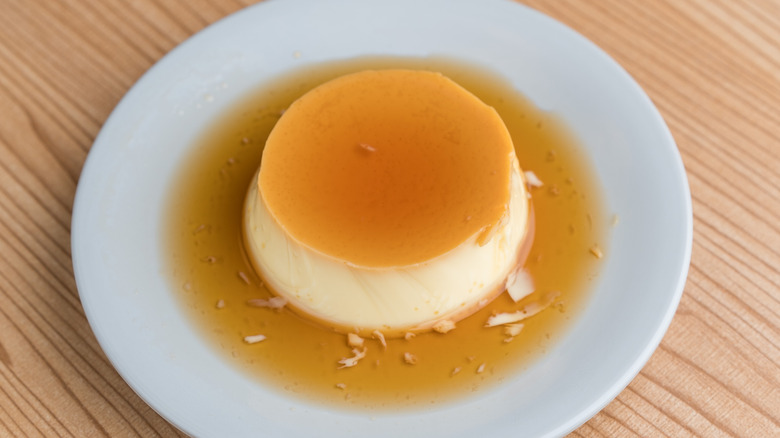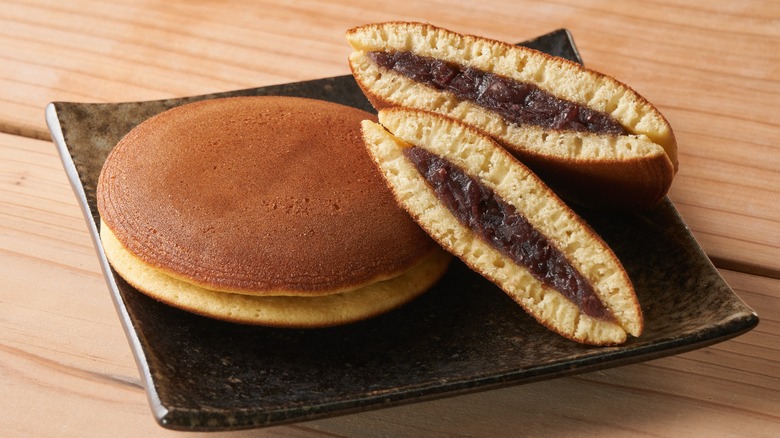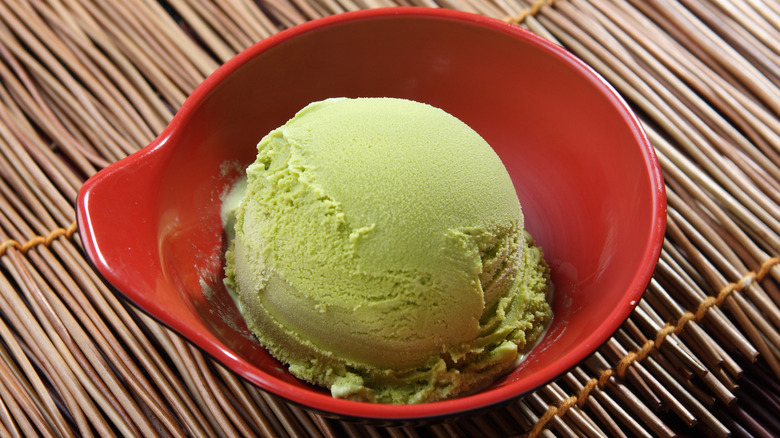18 Essential Words And Phrases To Know At A Japanese Restaurant
Undoubtedly delicious, Japanese cuisine is unique and packed with countless different flavors. It is where we get the fifth taste of umami. It is also somewhat different from what we are used to eating in the West. For starters, there is almost zero baking involved. (Ovens are extremely uncommon in Japanese homes.) Food is far more likely to be grilled or fried or come beautifully laid out atop a bowl of broth. How a dish looks is almost more important than how it tastes in Japanese cooking.
So, it's understandable that the menu at a Japanese restaurant may cause some confusion. You may not know where to start. It is true that some Japanese dishes include raw meat, usually fish, but that is only one small part of it. You can absolutely dine well on food that has been thoroughly cooked at a Japanese restaurant. And if seafood is not your thing, rest assured there are plenty of unfishy options. Japanese cuisine is also fairly accommodating to vegetarian diets as well if you know what to look for. That is where we come in. Allow us to guide you through the most common Japanese words and phrases that you are likely to encounter at a Japanese restaurant.
1. Irasshaimase
Let us begin with the moment you step through the door. Someone, or quite possibly every staff member in sight (we're not kidding), will call out a hearty, "Irasshaimase!" (Pronounced ee-rah-shy-ma-say.) If they're being informal, it is shortened to just "Irasshai!" It cannot be stressed enough that you, the customer, do not repeat this back to them.
Contrary to popular belief, irasshaimase does not mean hello. It means something akin to "please come in," but it has more of a sense of "welcome" in English. The restaurant employees are welcoming you into their restaurant. So, if you say "irasshaimase" back to them, it just sounds weird.
No response on your part is required. A smile and a nod are all you really need to be polite, but if you would like to respond, you can simply answer with a hello. If you would like to answer in Japanese, try "konnichiwa" (kohn-nee-chee-wah), the Japanese word for "good day."
2. Edamame
One of the first things you may notice on the menu under appetizers is edamame (pronounced eh-dah-mah-meh, it is both a singular and plural word). This is often translated to soybeans in English, but specifically, edamame are young soybeans, picked when the bean is still tender and easy to eat. (Soybeans picked at a later stage, when the beans are harder, are used to make soymilk and tofu.)
Edamame are usually served steamed in their pods and topped with a sprinkle of salt. Do not eat the pod. It won't kill you if you do, but the pods are tough and not exactly a joy to chew. During the steaming process, the seams along the pod become loose and open easily. Simply bring the pod to your mouth, then apply pressure to the beans inside using your fingers or front teeth. They will pop through the seam and into your waiting mouth. A fun and nutritious snack, edamame should not be missed when ordering from a Japanese restaurant.
3. Maki
The rolls of rice, vegetables, fish, and seaweed (nori) that most Westerners think of when they see the word "sushi" are actually called "makizushi" (pronounced mah-key-zoo-shee) in Japanese. Maki means roll, so it's literally a sushi roll. There are many kinds of sushi, and this is just one.
There are also many kinds of "rolls." The large rolls that are about two inches in diameter are called futomaki (foo-toe-mah-key). Temaki (teh-mah-key), or hand-rolled, are made by wrapping the sushi ingredients in a cone of seaweed.
Despite what many think, fish is not a requirement of sushi, especially makizushi. Plenty of maki involves vegetables. Kappa (kah-pah) maki is a very popular sushi roll that is made up of sliced cucumber, sushi rice, and roasted seaweed, making it both vegetarian and vegan. A kappa is not a cucumber but rather a small mythological aquatic creature native to Japan. Kappa love eating cucumbers, thus this roll is named in their honor. Another classic vegetarian (though not always vegan) sushi roll is oshinko (oh-sheen-koh), or pickled vegetable. You are most likely to see it made with pickled daikon radish, sushi rice, and roasted seaweed.
4. Nigiri
Nigiri (pronounced nee-ghee-ree) is another kind of sushi that you will see at Japanese restaurants. These are the compact mounds of sushi rice with a topping, often a slice of sashimi, laid over the top. Sometimes a tiny bit of wasabi is placed atop the rice before the sashimi is put on. Unlike maki, nigiri has only one topping.
Here is where we explain that sashimi does not have to be fish, though it does have to be raw. Outside of Japan, sashimi is generally seafood, but within Japan, you will find lots of raw meat used as sashimi as well as toppings in nigiri, such as chicken, beef, venison, and even horse.
However, like sushi rolls, nigiri may also be vegetarian. A type of nigiri you will very likely find on the menu is made from sliced omelet and "tied" to the rice with a thin strip of roasted seaweed. The taste is sweeter than a Western omelet due to the addition of sugar and, occasionally, mirin (rice wine).
5. Tamago
Quite simply, tamago (pronounced tah-mah-go) means egg in Japanese. However, when you see it on a menu, it is more likely to refer to a special kind of Japanese omelet, as mentioned above. There are probably as many ways to make this omelet as there are people who cook it, but there are some common denominators such as sugar and soy sauce.
A special pan exists, though is not required, to make the perfect Japanese omelet, which is flipped and folded so many times that the end result looks like a yellow log. This makes it easy to incorporate into makizushi as well as nigiri. Unlike Western omelets, this omelet is often not served hot. It may be closer to room temperature or even chilled when saved for later or used as an ingredient in sushi. Japanese omelet is a popular addition to bento (ben-toe), which we cover more in depth below.
6. Unagi
Freshwater eel, or unagi (pronounced ooh-nah-ghee), is very popular and stands apart from other seafood in Japan because it is always cooked. If you were to ever come across unagi sashimi, you had better steer clear because, quite frankly, raw freshwater eel is poisonous. Unagi is grilled or steamed and used in sushi or served on its own.
Unagi is often grilled in a special sweet sauce that is commonly referred to simply as eel sauce. This sweet and salty wonder is made up of dark soy sauce, mirin, sugar, and sake. The savory flavor pairs well with sushi rice, but you may also find this type of unagi served alone on skewers with a steaming bowl of white rice on the side. While it isn't as often seen in the U.S., unagi is also sometimes grilled without the eel sauce and with salt as the only seasoning. This method really puts the flavor of the unagi itself on display.
7. Soba
Soba (pronounced soh-bah) means buckwheat, which is not actually a wheat but a seed. One of Japan's tastiest noodles is made from soba. Soba noodles (or just soba for short) are served both hot and cold, depending on the season.
Chilled soba noodles served with a dipping sauce on the side are a terrific summer dish. The noodles, which are typically piled onto a special bamboo tray, are lifted with chopsticks, dipped into the sauce, and then slurped. The louder one slurps, the more they are said to be enjoying the meal.
In winter, a hot bowl of soba in broth with various toppings of choice served on top warms the body and soul. One traditional bowl of this variety is called kitsune (kee-tsoo-neh) soba. The toppings are simply sliced fresh green onion and fried tofu. Kitsune means fox, and it is believed that foxes love fried tofu, hence the name. Note that yakisoba (yah-key-soh-bah), stir-fried noodles, is not made with these buckwheat noodles.
8. Udon
Another popular Japanese noodle is udon (pronounced ooh-doh-n). Udon noodles are thicker than soba noodles and are made from wheat flour. Udon is lighter in color than soba as well. Depending on the season, udon is also served hot or cold.
Chilled udon is served with a dipping sauce on the side, like chilled soba, or as a cold soup. Also, like soba, udon can be served in a bowl of hot broth with an array of toppings. A popular hot bowl of udon is curry udon. Japanese curry roux is added to the broth to make a heartier, more flavorful dish. Because Japanese curry is less spicy than most Indian curries, even people with a lower spice tolerance may still enjoy curry udon. You will also find kitsune udon on restaurant menus, which is the same as kitsune soba but with udon instead of soba noodles. Unlike yakisoba, yaki udon is indeed made with stir-fried udon.
9. Ramen
Ramen (rah-men) is probably one of Japan's most famous dishes. The world may never know how many cups of instant ramen are consumed by college students every day the world over. So, you may think you know ramen. But unless you have enjoyed a steaming bowl of freshly made ramen from an experienced ramen maker, you do not.
Like udon, ramen noodles are made from wheat, but the texture is less chewy than udon noodles. Ramen noodles can be either thick or thin, and while soba tends to always be thin, udon is generally thick. Due to the special alkaline water that ramen noodles are boiled in, their color has a yellow tinge that the other two noodles lack. Also unlike other Japanese noodles, ramen is always a soup, though the broth may vary quite a bit. Miso (me-soh) ramen, for example, has salty miso paste in the broth. A word of warning to those who cannot eat pork — many varieties of ramen make their broth using pork bones, so be sure to ask before ordering if this is a concern.
10. Donburi
Donburi (pronounced doh-n-boo-ree) means "big bowl." It is a bowl of rice with whatever toppings you desire piled on top. You can recognize a donburi by the addition of "don" to the end of the word, and there are several very beloved dons that populate Japanese menus.
Oyakodon (oh-yah-koh-doh-n) literally means "parent and child bowl." It is made using chicken (the parent) and eggs (the child). As morbid as that may sound, it's actually pretty tasty. Plus, the combination of chicken and egg was made famous by Paul Simon in the song "Mother and Child Reunion," the title of which was inspired by seeing a chicken and egg dish of this name on a Chinese restaurant menu.
Gyudon (gyoo-doh-n) is a beef bowl. Thinly sliced cuts of beef are cooked in a sweet and salty sauce along with onions, then piled on top of the steamy white rice. The juices from the beef are absorbed by the rice, making this an all-around flavorful dish. Another popular don is katsudon (kah-tsoo-doh-n) made with a fried pork cutlet. More on that later.
11. Yaki
Put simply, yaki (pronounced yah-key) means grilled. This could be a charcoal grill or a flat-top griddle or even the best frying pan in your kitchen. Think of yaki as a loose term rather than set in stone. And there are so many different kinds of yaki out there.
We'll start with okonomiyaki (oh-koh-noh-mee-yah-key), a kind of cross between a savory pancake and a pizza. The name means "whatever you want grilled," although, in the U.S., you are less likely to have a choice of toppings as you are in Japan. Of the two main styles of okonomiyaki, Hiroshima and Kansai, it is noodleless Kansai that you are more likely to find in the U.S.
Another popular yaki is yakitori (yah-key-toe-ree), literally "grilled chicken." Remember that when you see things like "yakitori steak" on a menu. Bite-size pieces of chicken are grilled on bamboo skewers, making this a great street food. While the meat is grilling, it may be basted with a sauce or otherwise seasoned.
Takoyaki (pronounced like taco) are bite-size pieces of octopus (tako) are battered and grilled or fried into balls. They are predominantly associated with the city of Osaka, where they are a common street food. Sukiyaki (soo-key-yah-key) has debated origins, which also includes its name. It is a one-pot dish of meat and vegetables cooked in an iron pot. We did say yaki is a bit of a loose term.
12. Tempura
Tempura (sometimes spelled tenpura but still pronounced tem-poo-rah) means that a food has been battered and fried. This style of cooking was first introduced to Japan by Portuguese Catholic missionaries in the 1500s. The word actually comes from the Latin word "tempora," which refers to a time of fasting. The missionaries liked to make vegetable tempura during Lent.
Surprisingly, tempura is light and crispy and rarely greasy. It is served with a sweet and salty dipping sauce. Also, just about anything can become tempura, from whole shrimp to cobs of corn to soft-boiled eggs. When you see tempura on a menu with no other explanation, it is likely to be a mix of things such as a slice of sweet potato, button mushrooms, carrots, onion, pumpkin, shrimp, and chicken. It can be fun to guess what each piece of battered food is before you put it in your mouth. Like Japanese omelets, tempura is a common addition to bento. But more on that below.
13. Katsu
We've already mentioned katsudon. Now it's time to explain the katsu part. This is a shortening of the Japanese rendering of the English word "cutlet" when it became "katsuretsu" (kah-tsoo-reh-tsoo) in the Japanese syllabary. A cutlet is a breaded piece of meat that is then either grilled or fried.
Probably the most popular katsu is tonkatsu, literally a pork cutlet. You may also find chicken katsu, a breaded and fried chicken cutlet. Sometimes in the West, people don't realize that the ton in tonkatsu means pork, so you may also see chicken tonkatsu to mean a chicken cutlet. Similar to tempura, just about any sliced meat can be turned into a katsu. It is usually accompanied by savory tonkatsu sauce, which really goes well with any fried food. In addition to katsudon, there is katsu curry, a cutlet covered in curry beside a bed of white rice, and katsu sando (sah-n-doh), or a katsu sandwich.
14. Bento
After mentioning bento (pronounced ben-toe) a few times, we should probably explain it. The reason we waited so long is because so many of the above items can be found in a bento. Bento is not a food but a style of serving food, so to speak, that you often see on Japanese menus. This is why you also may see them called bento boxes.
A bento is, essentially, a boxed meal. The word comes from a Southern Song Chinese slang word meaning "convenient," which bento definitely is. When ordered at a restaurant, a kind of tray with deep dividers will be brought to you. Each separate compartment may contain sushi, omelet, tempura, tonkatsu, grilled fish ... The list goes on. There will most likely be a portion of white rice, though occasionally you might have noodles instead. The rice often is topped with a sprinkle of sesame seeds. If you aren't sure what to order, getting a bento is a terrific option. However, like a boxed lunch in the U.S., they might only be available for lunchtime rather than dinner.
15. Nabe versus shabu-shabu
Nabe (pronounced nah-beh) and shabu-shabu (shah-boo-shah-boo) are hot pot dishes, which are like communal soups. A pot of broth is set over a heat source in the middle of the table, and everyone seated at the table partakes. The word nabe means pot, and shabu-shabu is an onomatopoeia. It either is meant to imitate the sound of the boiling broth or the sound the ingredients make as you "swish" them through the broth to cook them.
Shabu-shabu is a type of nabe with which all of the ingredients start out raw and are cooked by the diners. This can be a very fun activity in addition to being delicious. Each pot of shabu-shabu is going to turn out differently since it is unlikely everyone will put in the same food in the same order at the same time every time. It is customary to use serving chopsticks and a ladle to remove food from the pot. Using the chopsticks that you are eating with in the communal pot is not the most sanitary. If the idea of cooking your own food intimates you, order one of the other nabe instead, like sukiyaki.
16. Purin
To some, it is crème caramel. To others, it's flan. In Japan, they call it purin (pronounced poo-reen), and it's a popular dessert often found on restaurant dessert menus. It is not entirely clear where the name purin comes from, but it does vaguely resemble the English word pudding, so this is the likely source. Purin is, after all, a custard pudding made from eggs, milk, and sugar with a thin caramel sauce spooned over the top. It was brought to Japan by Europeans sometime during the late 19th to early 20th centuries.
Purin is rich and sugary sweet and has a delightfully silky smooth texture akin to the custard in crème brûlée. It is served cold and makes a delicious and indulgent end to a Japanese meal. If you are a fan of either crème brûlée or flan, then you will undoubtedly love purin as much as we do.
17. Azuki
Whether spelled azuki, adzuki, or (uncommonly) aduki, this Japanese word for red beans is pronounced "ah-zoo-key." Azuki, also called azuki beans, are often used in Japanese desserts and snacks. When made into a sweet paste, it's called anko (ah-n-koh) or red bean paste, and is used as a filler for bread, buns, and pastries or as a topping for ice cream and shaved ice. It ranges in texture from smooth to chunky.
Japanese restaurants in the U.S. often include a scoop of azuki ice cream on their dessert menus. We promise it really is sweet, though some may find the texture of the frozen beans scattered throughout the smooth ice cream a bit strange. It's difficult to compare it to anything except a cooked bean. Not crunchy, but not smooth either. It might be difficult to get past the idea of beans as a dessert, but if you see azuki ice cream or another azuki confection, it's worth giving it a try. You might be surprised by how much you like it.
18. Matcha
Matcha (pronounced mah-chah) is what you get when dried green tea leaves are ground into a fine powder. And yes, it really is that shade of bright green. Aside from making traditional Japanese tea that is used in tea ceremonies, matcha is used in various recipes including pastries and other sweets.
In addition to azuki ice cream, matcha, or green tea, ice cream is another popular dessert found on restaurant menus. The matcha adds an earthiness to the otherwise sweet, creamy dessert. Even more spectacular is tempura matcha ice cream, a Japanese take on fried ice cream.
In order to withstand the heat of the fryer, the ice cream is wrapped in cake or soft bread before being dipped in tempura batter and then fried. Warm and crispy tempura on the outside, and soft and chilly matcha ice cream on the inside, tempura green tea ice cream is a near-perfect blend of different Japanese flavors as well as cooking techniques. We understand if you skip straight to dessert for this one!
